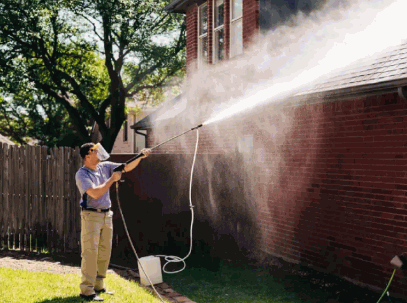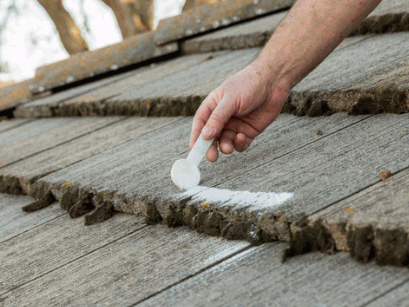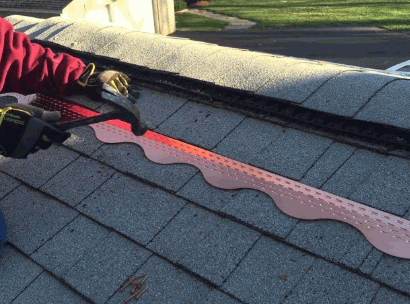Roof moss is a common issue that many UK property owners have to deal with. Our damp, cool climate creates the perfect breeding ground for moss growth. It doesn't just have a negative impact on the appearance of your home. Moss can damage roof tiles, affect drainage, and even shorten the roof's lifespan. Thankfully, there are a variety of methods that can be used to remove moss from your roof, including manual and chemical techniques. Read on to find out everything you need to know about removing moss from a roof.

If you have a moss-covered roof, your first thought will probably be about how unsightly it is. But if you look beneath the surface, you will see that the moss is causing more damage than it first appears.
While moss doesn't have particularly long or deep roots, it still has roots. These anchor the moss to the roof tiles. In doing so, they can pry the tiles slightly apart or lift them from their original position. This is most likely in larger patches of moss where it is thick or has formed clumps.
This movement of the tiles creates tiny gaps that allow rainwater to seep through to the roof structure beneath, and will compromise the waterproofing of the roof. Over time, the water ingress can lead to leaks and internal water damage.
Moss is sponge-like. This means that it absorbs and retains water from rain, morning due, and fog very effectively. Because the water is trapped in the moss, it takes a long time to evaporate, and the tiles will remain damp for extended periods of time.
This prolonged exposure to moisture can degrade the roof tile material. This is particularly the case with porous roof tiles, such as clay or concrete.
Moisture retention can also increase the risk of mould, mildew, and rot.
In the colder winter months, the moisture retained by the moss can freeze and expand, which can lead to small cracks in the roof tiles, before thawing again. Moisture then enters these cracks, freezes and expands, widening them.
As this cycle continues, the cracks can become deeper and wider, leading to the tile's material becoming degraded and water infiltration to the roof structure below more likely.
Your roof has a well-designed drainage system, and the purpose of it is to get water away from the roof as efficiently as possible. Moss growth can interfere with this system by, for example, blocking gutters or drainpipes.
Instead of the water leaving the roof quickly, it will sit on the roof. This is known as "ponding water", and can penetrate roof tiles and cause interior leaks.
In the most extreme cases, a drainage system blocked by moss can lead to water damage in the roof structure, the building's walls, and even its foundation.

If moss growth is left untreated, moisture can seep into the wooden elements of the roof, such as rafters and decking. Prolonged exposure to moisture can cause the wood to rot and weaken. Over time, this can cause the roof to sag, and you may soon be faced with extensive repair work needed, such as a roof replacement.
It is generally advisable to seek professional help when doing any work on roofs. The height and risk of slips and falls make cleaning roof moss potentially dangerous.
If you do choose to remove the moss yourself, you will need to ensure that you are making safety a number one priority.
Make sure that you have all of the safety equipment you need. This should include:
You will need a sturdy ladder that will stay in place. A specialist roof ladder is the best option, as this is designed to securely attach to a roof.
In some situations, scaffolding will be needed to remove moss safely.

You should never work on a roof alone. There should always be someone with you who can help, or call for help, in an emergency.
If you are unsure about whether your roof is safe to work on, it is always better to call a professional.
Manual removal involves cleaning moss off the roof using some tools and a bit of elbow grease, and it can be surprisingly effective.
Scraping moss from your roof should be done on a dry day. Start at the top of the roof and move down in sections, gently scraping off the moss using a trowel or scraper.
Once you have removed as much as you can with a trowel, you should go back over with a stiff brush to remove the loose moss that's left. If it is difficult to remove, you can use a garden hose to wet it and help with the brushing.

There is a wide range of commercial solutions available that will kill and prevent moss from regrowing. Some types can be applied to the moss and left to do their work, while others are designed to be attached to your garden hose and sprayed onto the moss.
Always follow the manufacturer's directions for how to apply and handle the moss remover safely.
You can make your own moss killer using products that you have at home. Chlorine bleach is effective at killing moss, but it will also damage plants that you actually want to keep. If you are using this solution, you should cover any surrounding plants with plastic sheeting to protect them.
Mix one litre of bleach with one gallon of water, and a few drops of detergent and apply it liberally to the moss.
For a less toxic solution, you could use vinegar or baking soda. These won't kill the moss directly. Instead, they alter the pH of the moss and inhibit its growth. The moss will stop growing and eventually, the remaining moss will die off.

Once the chemical treatment you have chosen has done its job, you will need to remove the dead moss. You can do this manually using a trowel and a stiff brush.

Removing moss is a time and energy-intensive task, and there are methods that can prevent moss from returning, so you won't have to do it as often.
Moss loves dark, shaded areas. If you have trees with branches that hang over your roof, trimming these back can make it less likely that the moss will grow back.

Laying zinc or copper strips along the edges of your roof will help to prevent moss from growing. These are chemical-free and environmentally friendly options. They are both triggered by oxidisation caused by rainwater hitting the metal strips.
When zinc oxidises, its particles are released and these trigger the moss to keep eating and drinking repeatedly until it dies.

Copper particles work slightly differently. They release ions that prohibit the growth of the moss, preventing more from appearing.

While removing moss from your roof can be done yourself, it is often better to bring in a professional roof cleaning company.
Working on a roof brings with it clear risks because of the height and risk of slipping, especially when dealing with moss and liquid.
A professional company will be trained in all the proper safety protocols for working at height, and will have the necessary protective gear to prevent falls and injuries.
A professional cleaning company has the training to remove moss effectively, and without risking any damage to the asphalt shingles. This can be a delicate balancing act that requires experience and specialist knowledge.
They will also be able to use more powerful equipment, like a power washer or pressure washer, without risking any damage to the roof tiles.
Removing moss can be time-consuming. Manual removal can be slow-going, and may need to be repeated. It can also be a multi-day task if you are waiting for a moss killer to work. Using a professional company takes the issue out of your hands, freeing up your time and energy.
Check out our post “How to clean a roof professionally”.
If you are dealing with moss growth on your roof, we can help. We understand the importance of killing roof moss to protect your roof shingles and the underlying roofing materials, and we always ensure that every trace of moss is removed and future moss growth is prevented.
Our team will inspect your roof for damage and assess the current moss growing. We will then develop an effective plan to remove the moss and stop it from coming back, without causing any damage to your roof.

Roof moss looks unsightly, and can cause serious damage to the roof tiles and the roof structure if left untreated. There are various methods to remove moss, including both manual and chemical techniques, and you can prevent it from coming back using metal strips and cutting back trees. It is usually better to use a professional service rather than removing moss yourself because of the risk of fall and injury, and to ensure that the moss is fully removed without damaging the roof tiles.




